Greetings on the June solstice. In the northern hemisphere, it is the longest day of the year. When I lived in Nizhny Novgorod, Russia, the sun edged just below the horizon and only the brightest stars could be seen. This form of twilight is known as “nautical twilight” because sailors could still see important heavenly bodies well enough to navigate by them. I didn’t know that term then. I only knew that it was magical to sit with friends watching the luminous horizon at their dacha after a day of picking vegetables and fruits from their garden.
I have one more solstice story. Twenty-six years ago, when my wife Lisa and I moved to the Boston street where we still live, we joined our neighbors to clean the sidewalks and gutters. By taking care of the street, we got to know each other. Lisa suggested we have a block party. It wound up being on the 21st of June. The police let us close the street, people brought food and drink, and I put speakers in our front windows facing out, playing a selection of songs from James Brown, Diana Ross, Aretha Franklin, and Earth Wind and Fire. Kids danced around on the cobblestones. We called it the Soulstice Party.
Both of these memories are vivid, likely because I observed and internalized things that felt not only special, but enduringly true. Happily, friendship, watching the heavens, and dance remain sources of uncomplicated joy, but much of life has become complicated, and facing climate change can make it bewilderingly so. In the past year many people have reached out to me openly admitting that after decades of success they have realized that the world is in peril and that they don’t know how to proceed. I am asked “What should I do?” so often now that I figured I should share my answers with this community.
Moving beyond “It’s not my problem”
When I began focusing my energies on climate change and its implications about 8 years ago, most people I talked to immediately reacted with denial. In the investment business there were many who didn’t “believe” in climate change, and even more who said they weren’t “sure” it was happening. The language they used piqued my interest, because they were supposed to weigh payoffs under uncertainty, not hold binary “beliefs.” They couldn’t wait to be “sure” about things and expect to earn the returns their clients were paying for.
What I found more interesting, though, were the people who did believe and were sure. Almost all of the people I knew well were in this group. Despite their belief, almost none of them were acting on it. I was like them. I was pretty sure climate change was serious. I understood what caused it. Yet my behavior didn’t reflect that knowledge in any meaningful way.
When I shared my growing body of work with these folks, they almost universally reacted by talking about the deniers, about specific politicians, about China or India. About someone else. The term “someone else” became something of an obsession for me. After a year or so of talking to people about climate change more consistently and insistently than they were used to, I wondered how it was that we could see ourselves as irrelevant to—or even outside of—something that affected everyone.
There was a portfolio manager at my old firm whose reputation was built on having uncomplicated reasoning and making decisions judiciously. I’ll call him Ronald. One day after I had shared some of my work, Ronald approached me with an avuncular air and offered these words of comfort: “Don’t take it personally. It’s just a tragedy of the commons. There’s nothing anyone can do about it.”
“Tragedy of the commons” is an economic concept coined to express a particular kind of potentially catastrophic risk in which shared resources are ruined by overuse or abuse. It was coined in 1833 when industrialization was taking off and the field of economics was still rooted in moral philosophy. By the time I received my PhD in economics in the late 1990s, the field had moved assuredly from risk and morals to optimization and maximization, with the highest regard going to work which proved that markets were answers to whatever ailed society.
In 2009 the economist Elinor Ostrom won a Nobel Prize largely for her work on how private markets can solve problems of the commons, citing examples of small communities who figured out how to allocate common local resources like water and fishing or grazing rights. Ostrom’s work is elegant and inspiring, but it has a huge “someone else” problem.
Someone else
“Someone else” is a modern term. It’s not you, me, them, us, Ronald, Roberta, Roberto, Rohini, Rohit, or anyone else whom I can name. It’s not even a role like Principal, President, Mayor, CEO, or Founder. It’s probably a person, but when we use the term it’s because we don’t know who it is. In Ostrom’s work, tragedies are avoided because all of the people who share a common resource, know each other, are able to communicate with each other, have clear property rights, and share an enforcement framework that they can agree upon. I know you, you know her, she knows them, and if we don’t agree or if I break our agreement, you can invoke some known authority to punish me.
Around the time that the Nobel committee gave Ostrom her prize, Google completed an effort to scan all the books in a number of huge libraries around the world. This effort to make common knowledge truly common resulted in one of the curiosities of the Internet to which I often return: The ngram viewer.
The ngram viewer allows you to see how often words were used in books from 1800 through 2019. You can type in a word or phrase and a graph will pop up. This graph will tell you for each year, from all of the books in whatever corpus you choose, what percentage of all of the words are the ones you typed in. Take for example, the frequency with which two different public health problems appear in American English books (fiction and nonfiction):
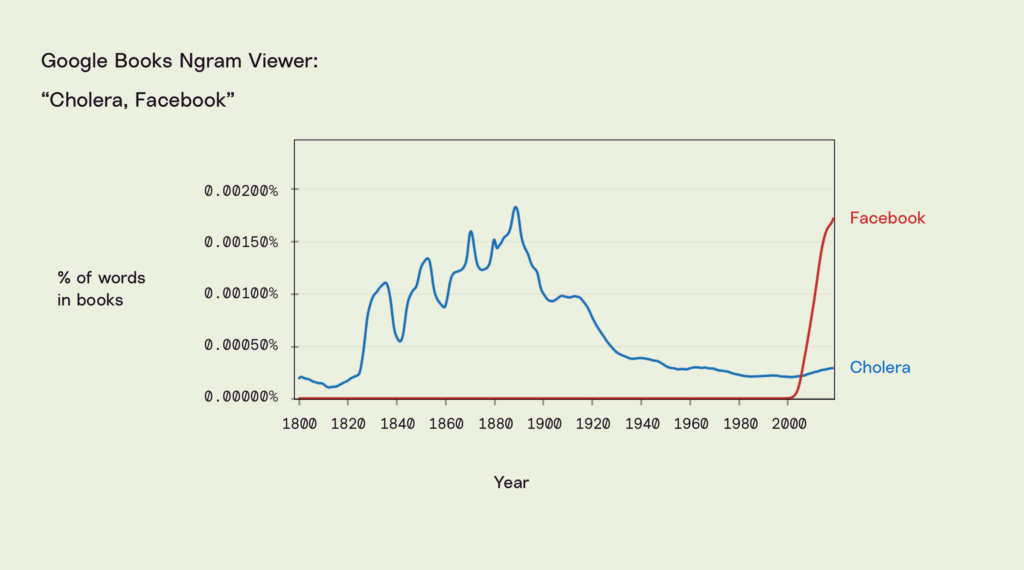
The graph is a specific record, revealing the outbreaks, subsidence, and eventual rarity of cholera (both capitalized and lowercase spellings). Cholera was a very successful bacterium for a century in the US (and much longer elsewhere) before it prompted cities to invest in public goods and infrastructure. Facebook has been virally successful in its pursuit of its corporate mission to “Move fast and break things,” and we are now trying to figure out what public goods might keep it from breaking more things.
The hard truth is that we don’t live in the world of Ostrom’s examples. We live in a world of enormous scale in which common resources are shared by so many people that it is overwhelming to think about, and in which systems like modern business and technology are so complex that they feel like magic. Collectively, we are inconceivably powerful while individually, we feel atomistic. We often don’t know whom to turn to when we are lost or frustrated or when something doesn’t work, and when people turn to us, we can confidently tell them that they are actually looking for someone else.
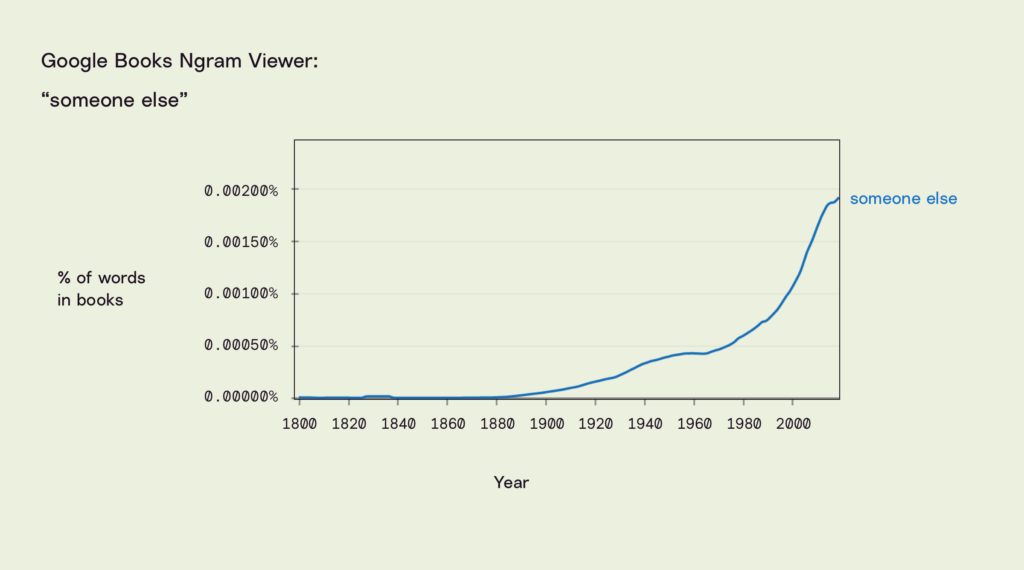
I haven’t spoken with Ronald and his team in a few years, but executives from many companies whose stock they bought have been reaching out to me in hopes that I can help them. Some have had a personal epiphany, but most are feeling the pressure from others asking them, “What are you going to do?” Just replying, “It’s a tragedy,” or “It’s someone else’s job,” is no longer sufficient.
On giving advice
Probable Futures will not be an advice-giving platform. It won’t have clever answers or counterintuitive takes on things that will surprise you. I am confident, however, that it will help you understand that a stable climate is the foundation for civilization, what is coming that we must prepare for now, what we can at least delay, and how urgently we need to act to avoid risking much of what we enjoy about life on Earth.
When people come to me for guidance, however, I try to help them frame their thinking and benefit from my 8 years dedicated to this topic, which has included countless hours reading and investigating data, hundreds of conversations with people in myriad fields, even more hours letting the reality of what I have learned sink in, and then rich, heartfelt conversations with people who are also wrestling with what it means to live at a time when we know that every day we each put molecules into the atmosphere that will be there centuries from now, making the world ever so slightly warmer for every living being to come.
I don’t have anything close to a complete recipe for “What should I do?”, but I have a simple list that can be a starting point for anyone:
- Stop doing things you know are wrong
- This is your best/last chance for leadership
- Orient yourself to zero, not “less”
- “Net zero” is not zero
- Listen to young people
- Dance
Having offered a succinct list, I’ll elaborate:
Stop doing things you know are wrong
When people ask me “What should I do?” they usually mean, “What new thing should I do, or buy, or invest in?” My first reply to them is simply “Start by figuring out what you’re doing that is pretty obviously wrong.” It is often jarring for them, but only briefly. Almost all of us can see such things, be they very small or enormous.
For example, people who fly for work all the time have the biggest individual impacts on the planet. When such people asked me what they should do, I would suggest, “Try not flying for a few months and see what happens.” No one tried. And then COVID-19 revealed to every one of them that a different life was possible and that they didn’t need to fly like that to do good work. COVID solved a coordination problem: no one dared be the first to stop something, but once they were forced to, it was easy.
This is your best/last chance for leadership
I have been very fortunate to have people with a great deal of influence come to me for advice, guidance, or in hopes of connecting with someone who could understand both climate change and their own personal or institutional context. They have arrived through a variety of different channels and I am always willing to talk with them, even if they are reluctant. “Apparently I am supposed to talk with you,” is how one such person started a meeting.
I explain this cultural change to point out something that makes me perversely hopeful: In essentially every industry, and across almost all large countries, there is still a giant opportunity for leadership. Most of the people who come to me from the executive suites want to see themselves as dynamic leaders. They want to have a legacy. I tell them how lucky they are: Having done nothing about climate change for their entire careers, they still have a chance to be a leader. I also tell them that if they want to have any claim at leadership they must act quickly and boldly.
First, doing something to improve the climate is now popular. Most leaders are still afraid of deniers, but if you lead a large organization that has any international exposure, you are almost completely surrounded by people who know something is wrong. “It’s the most popular thing I have ever done!” is the most common feedback a few weeks after an action.
Second, what counts as daring, or even leading, is changing fast. In the last year almost every institution has done something. A few weeks after releasing a statement that had been painstakingly edited by Legal and PR departments, most of these leaders discover that they have a competitor or peer who is ahead of them. “We want to be ahead of everyone else,” is now a common introduction to a meeting. The world needs this competition. It needs to be towards the right goal.
Orient yourself to zero, not “less”
The word “sustainable” means “able to be maintained at a certain rate of level.” Unfortunately, the corporate use of the word, and its sibling “sustainability,” are implicitly defined as “less unsustainable than what we used to do.”
At the outset of this project I was talking with someone who was building a business to sell to the growing ESG (environmental/social/governance) market and wanted more “sustainability” data. About 15 minutes into the conversation, I had to stop and ask “What is your definition of ‘sustainable’?” The answer has rung in my head ever since, “That’s the beauty of our business model—it can mean whatever the customer wants it to mean.” This deceptive usage of a word that has a clear, useful meaning is something I hope to help people avoid. The good news is that there is an easy way to assess choices: If an action helps get us to zero emissions, it is positive; if it only gets us to “less,” don’t be so sure. Let me offer a powerful example.
Heating coal and exposing it to oxygen releases ancient energy and creates both heat and carbon dioxide. Since coal has a mix of different things in it, a lot of other stuff gets released, much of which is toxic. Burning coal to generate electricity thus both contributes to global warming and has other negative effects. We have to stop burning coal to achieve sustainability.
Methane (CH4) is a molecule with one carbon atom and four hydrogen atoms. Its bonds are strong. Breaking those bonds by exposing methane to a spark creates explosions of energy that generate tremendous heat and release CO2. That’s what happens when the boiler in my basement responds to a signal to create more hot water.
Methane was rebranded in the United States as “natural gas” to make it more attractive. And compared with coal, it is attractive. It has much less junk in it, so it burns cleaner, and its chemical bonds are more powerful than those in coal, so it is a denser form of energy. To generate a given amount of heat or electricity, methane produces about ½ the CO2 emissions of coal. Switching from coal to natural gas seems like an obvious way to limit atmospheric warming.
Indeed, the methane industry helped create a concept that became very popular in industry—a bridge fuel. The logic was simple: Methane isn’t zero carbon, but it’s better than coal, so it can act as a “bridge” from the dirty coal past to the zero emissions future. A scientist I admire once said to me, “I don’t think these people have really thought about how bridges work.” She was right.
We only use bridges when we absolutely have to. We don’t stay on a bridge when we can do something much safer, namely travel on land. Bridges end abruptly, but people were not acting as if using methane as a fuel would be a short-term endeavor that would end abruptly. Indeed, developing an entire infrastructure for methane was not done as if people expected to ever stop traveling on that bridge. Burning “natural gas” is now the dominant way the US generates electricity and the methane infrastructure of many countries is expanding quickly. Unfortunately, the idea that switching to methane from coal would cut greenhouse gasses in half falls apart if you think it through.
Before a power plant can generate a single kilowatt hour of energy, people and machines have to create, assemble, and install tons of steel and concrete, all of which releases new emissions. Pipelines are built to transport the fuel. Ocean tankers are built to ship it around the world as liquid natural gas (LNG). All of those actions create more emissions. So before you start, you’re behind.
Then there is the massive amount of energy used to extract the methane from the ground, the energy used in processing of the fuel so that the power plant only gets CH4 and not all the other stuff that was mixed up in the underground stew it came from, and the energy used to transport the fuel. Finally there is the energy used to maintain the infrastructure.
In 2012, the eminent climate scientist Ken Caldeira wrote a paper with the technologist and patent investor, Nathan Myhrvold. They asked a provocative question: How much cooler would the atmosphere be if we replaced a terawatt of coal-generated electricity (roughly equivalent to world coal electricity production at the time) with electricity generated by other sources? They walked through the kind of logic I offer above for methane, wind, solar, and hydro power.
Here’s a graph from their paper showing the results of a scenario in which coal is replaced by other sources over 40 years:
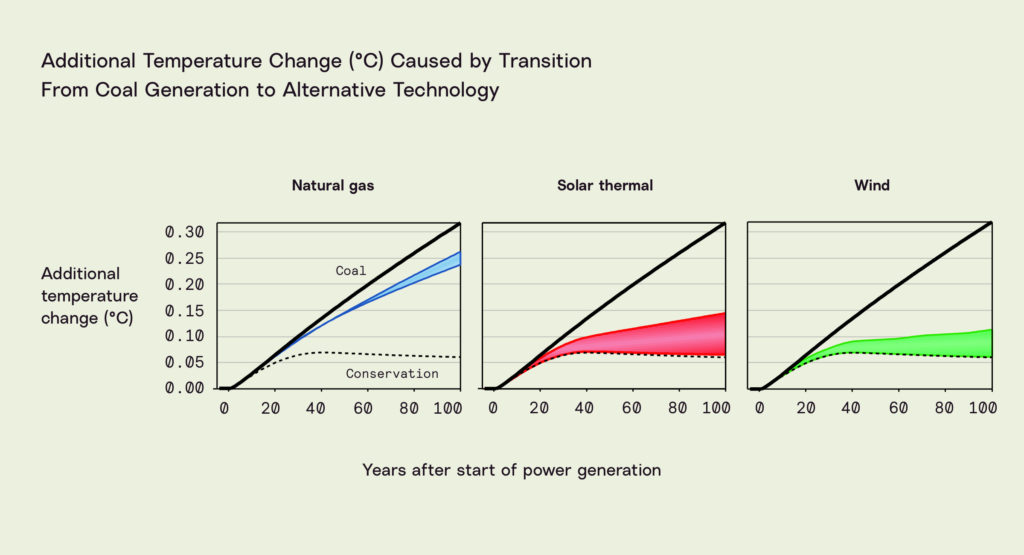
In each of the above graphs the black diagonal line is the contribution to global temperature if we kept burning coal to generate electricity (all other sources of greenhouse gasses like transport, agriculture, etc. are excluded). The dashed line is what would happen if the terawatt of coal electricity were replaced by phasing out use of this energy without replacing it. The colorful curves show a range of estimates of the effect of switching to natural gas, solar thermal energy, and wind. At the bottom of the colored ranges everything goes really, really well, in which case sources of energy that generate zero emissions once they are built can do nearly as well as conservation.
Natural gas? Here is a line from the paper’s conclusion: “Technologies that offer only modest reductions in emissions, such as natural gas… cannot yield substantial temperature reductions this century.”
I wish this limited thinking were the only shortcoming of the natural gas story. Methane needs to be extracted from the earth. Coal mining is hard work and often ecologically disastrous to the local community and ecosystem as waste and debris spill into streams and rivers. That debris does not add to global warming, however, as gravity keeps it from flying away.
The same is not true of methane. If methane leaks out, it quickly flies into the atmosphere where its particular molecular structure has a different power. CH4 is just the right size and shape to interfere with a particular bandwidth of radiation. A single molecule of CH4 traps about 80 times more heat than a CO2 molecule does. Therefore, if even a small amount of the methane that a driller dislodges from shale by fracking escapes, natural gas contributes more to warming than coal electricity does.
There is an uncomfortable fact about the atmosphere that is consistent with leaking. Around the time that the fracking boom started in the US, atmospheric methane began to rise:
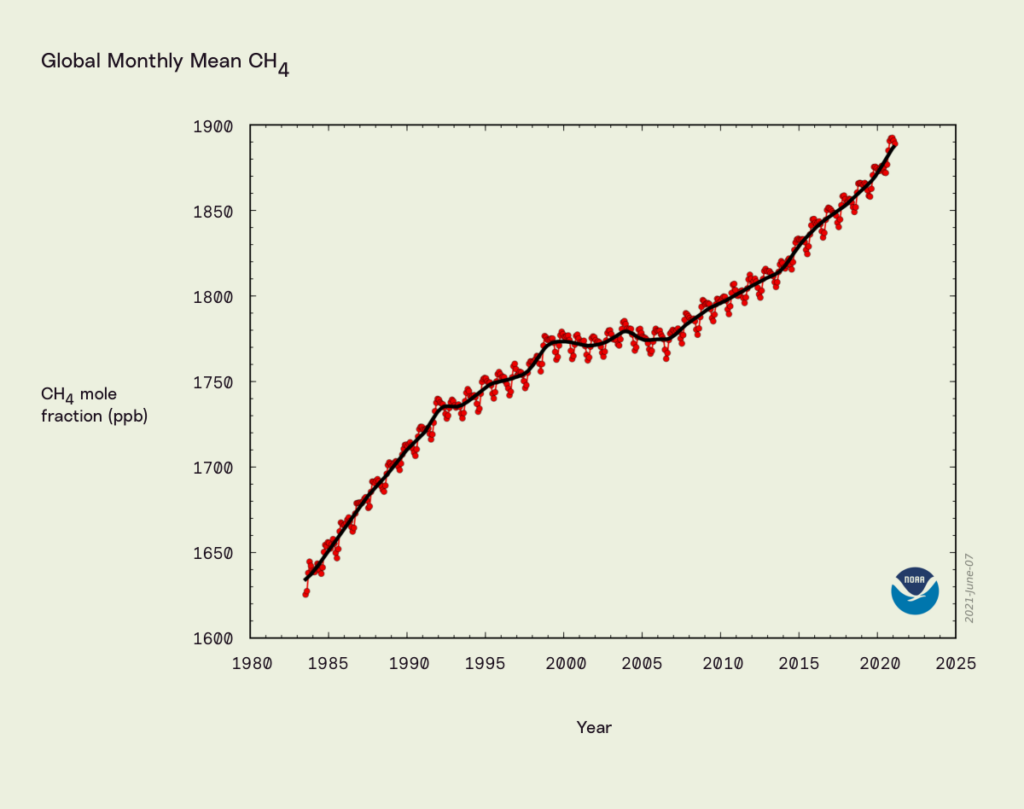
There is no way to prove that the source of this methane is leakage from fracking (or other parts of the natural gas delivery and combustion network, from pipelines to trucks to pipes in my city to the little bit that escapes when I ignite a burner on my cooktop), but the timing and scale are consistent with it. Unfortunately, as I discussed in my December 2020 solstice letter, that methane is now being joined by methane from thawing permafrost, which has the potential to permanently destabilize our climate.
Here’s what the concentration of methane looks like on a longer time scale, with today’s value in the top right corner:
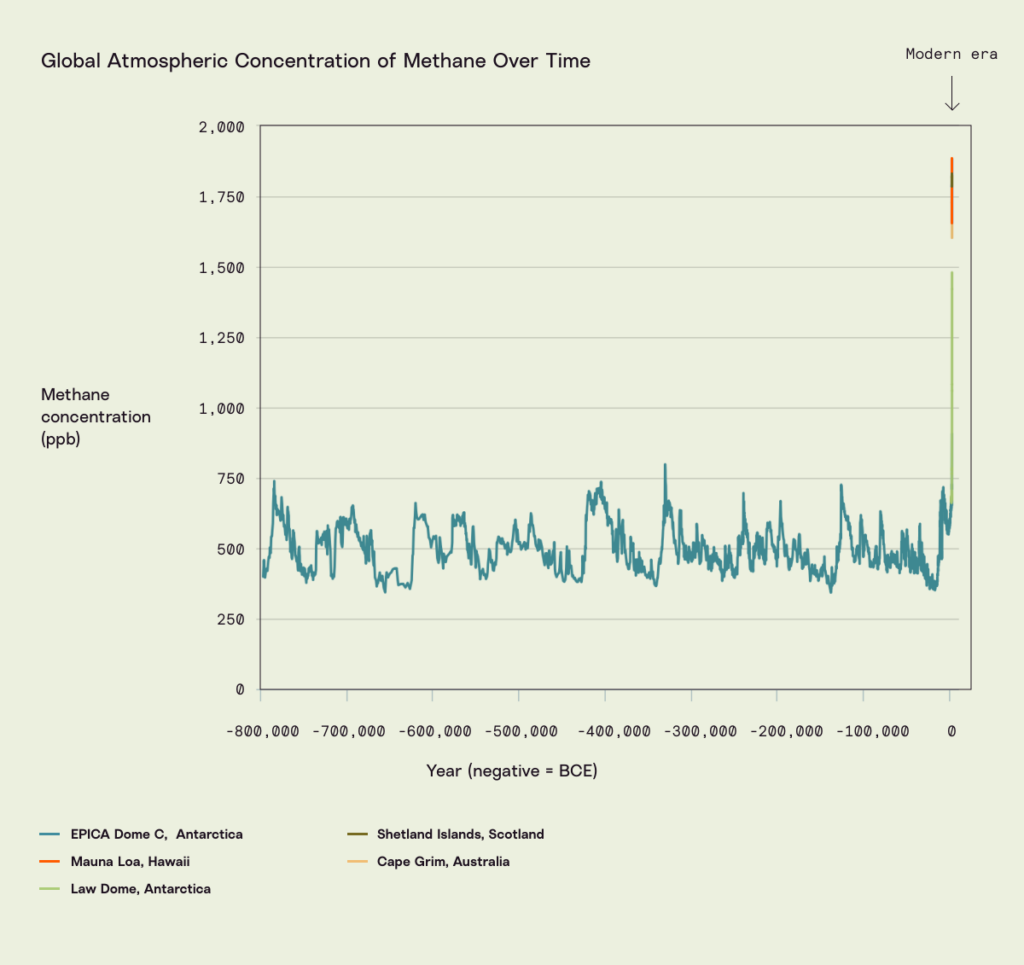
The message is simple here: Don’t replace coal power plants with methane/natural gas ones. Don’t lend to them, invest in them, approve permits for them, etc. The emissions gains are trivial at best, and by creating a new natural gas infrastructure, you are making it harder to get to zero.
Most readers of this letter probably don’t think that advice is relevant since they don’t own a power plant. In fact, however, most do. An automobile with a combustion engine is a small, mobile power plant. It takes petroleum in, exposes it to a spark, creates millions of explosions, and tries its best to harness the energy in those explosions to turn the wheels of the car.
Because this power plant is small and crammed inside of a vehicle, it is pretty inefficient. In an excellent engine, nearly 30% of the energy in the petroleum gets to the wheels, while the rest is wasted. In most cars it is substantially less. (If you look under the hood of the car, much of the equipment there is for dealing with heat and exhaust.) Most readers of these letters will be inclined to replace their cars at some point, maybe soon.
Don’t buy a new car with a combustion engine. Even if the new car has a more efficient engine, manufacturing and shipping generate emissions before it is ever driven. More consequentially, a new internal combustion engine car is likely to last over a decade and well over 150,000 miles, making zero emissions an even more distant target. My advice is simple: The next time you purchase a new car, make it an electric one. If you can’t afford to switch to an electric car right now, keep driving what you’ve got. If your car is at the end of its life and you need to replace it but can’t afford an electric one or want to wait for some new models in a year or two, buy a used car from someone else as a short bridge. There are more and better electric cars coming out all the time now, prices are coming down, and charging networks are improving. Like wind and solar power generation, it takes energy to build these cars, but once running they have zero emissions.
“Net zero” is not zero
Corporations are now tripping over themselves pledging to achieve “net zero” by some point in time. Virtually none of the companies are actually planning to stop emitting CO2 or CH4. Instead they are committing to paying someone else to take CO2 out of the atmosphere by planting trees somewhere else. Again the “someone else” problem. I understand that we don’t even know how to get to zero yet, but that is the goal. It’s not one action, but a change of mindset that will enable both a burst of activity now and the decade or more of work to come. That work will be done by young people, which leads to my next piece of advice.
Listen to young people.
A month or so after Ronald told me that climate change was a tragedy, he proudly told me that his daughter was studying ecology at a prestigious college. This has turned out to be a common theme: people who have been reluctant to act are proud to tell me that their children are studying environmental economics, ecology, botany, sustainability, environmental policy, or another field that will help them succeed in a world of physical disruption. Others have children who won’t eat meat, are fully vegan, or are refusing to go to school on Fridays to protest. When employers offer opportunities for young people to suggest projects, they are surprised by how many choose to work on climate projects.
Young people know. They will live with the consequences. They aren’t burdened by the difficulty of confronting choices that you and I made in the past that already look bad in hindsight. Listening to young people will help your organization. It will help you. It will also help your relationships with the young people in your life. After one conversation about this, my friend Dickon sent me this British poster from WWI.
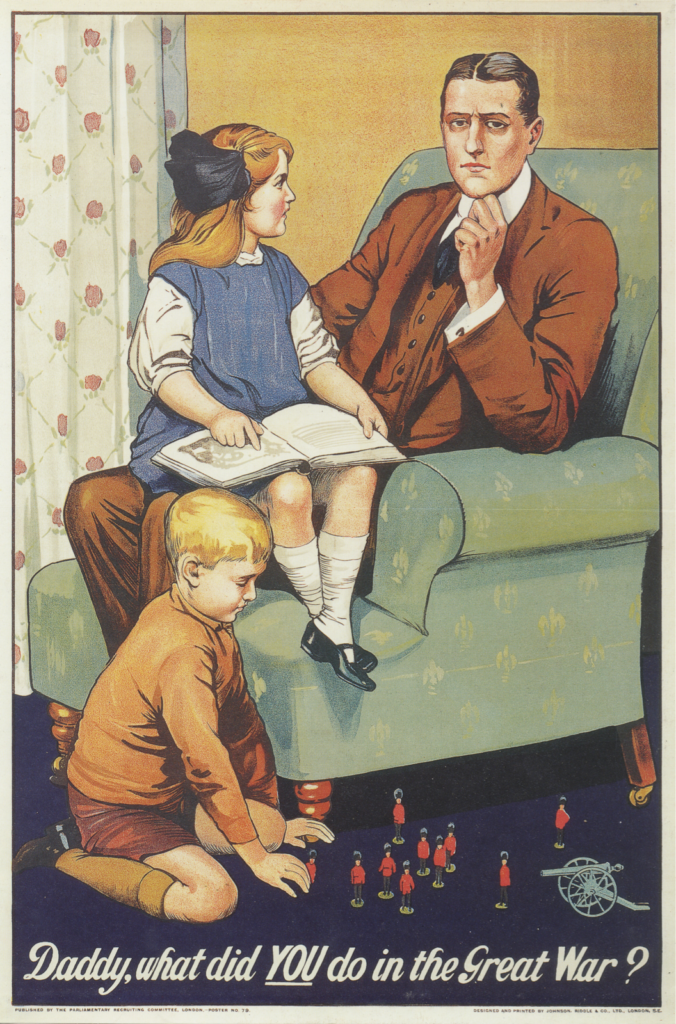
Insert the caption: “What did you do when you knew what caused climate change and how bad it could be?” and it might get easier to act courageously.
The other reason to listen to young people is that they have fun. Which brings me to my last piece of advice.
Dance
When I left the finance industry and started out on my own, solely focusing on doing what I could to improve the climate, I needed to create a new email account. In a small, personal way it felt momentous. It seemed very likely that the work would be depressing. Probably lonely. Certainly hard. I decided that I needed a way to remind myself every day why I was doing this. Perhaps a good email password would help.
In what proved to be a signal that maybe it wouldn’t be so sad, lonely or hard, I had a spark of inspiration. I chose “LessCO2MoreDancing!” It had lowercase and capital letters, numbers, and symbols, and it captured why I think this work can be rewarding. We could dance a lot more. And I happen to love dancing. Dancing with Lisa, with friends, or even all alone picks me up. I enjoy watching dance. When the words are by the author Hanif Abdurraqib, I even enjoy reading about dance.
Abdurraqib writes wonderfully about what it feels like to be alive, to have a body, and to have a relationship with music. His latest collection of essays, A Little Devil in America, is divided into sections. The first essay in each section is entitled, “Times I have forced myself to dance.” In his essay “Marathons and Tunnels,” Abdurraqib recalls how he felt watching the dance show Soul Train on TV as a child. He then shares the history of the show and its host in ways that inspired me. I knew that Don Cornelius was a cool, composed host of an exuberant dance show. I had no idea that Soul Train was his idea, and even less of a clue that it was in the service of social change.
“At his core, Cornelius was a journalist who was driven to journalism by a desire to cover the civil rights movement, with an understanding that the movement was inextricably linked to the music that soundtracked it. It acted as both a call for people to take to the streets and a reprieve after a long day of protest, marching, or working some despised job.”
Climate change doesn’t have a soundtrack yet, but to do the hard work we have to do together, we are going to need reprieves, rejuvenation, and spiritual, soulful, bodily joy, none of which requires emitting carbon into the atmosphere. We are acting too slowly and too late to save all that is good on Earth now, but if we act swiftly and decisively to get to zero, young people can expect a future that has plenty of dancing.
What should I do?
When I asked myself the question at the center of this letter, the answers included the same ones I offered above, but—as for everyone—that list was just a start. I realized there was more I could do, so I started, and Lisa and I made a commitment to fund, Probable Futures. I had confidence that it was the right answer. I just had no idea how great it could be, how much help I would get, or what kind of a community it could produce. I am excited to share it with you. It has taken longer than I anticipated, but I have never been a good one to ask for advice on how long it will take to do something.
I look forward to sharing more about Probable Futures in the coming months. Happy solstice.
Onward,

Spencer
Resources:
Hanif Abdurraqib’s book is A Little Devil in America: Notes in Praise of Black Performance. I also loved his Go Ahead in the Rain: Notes to A Tribe Called Quest.
The Caldeira and Myhrvold paper